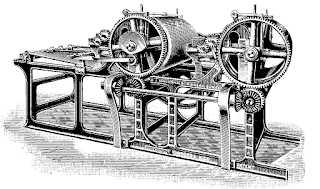Printing has been identified as the single most significant technology with logical development in the history of the human species. Prior to the invention of printing all information and communication was transmitted verbally or by means of traditional methods of writing. Ideas survived as long as someone could remember the concept. Little information was retained unchanged for more than three generations. Folklore and legend formed the base for all cultures. Before printing, it was very difficult to communicate messages to a large number of people. The oral tradition was limited to small groups and the memory of the speaker.
Around 175AD, the Chinese began the practice of cutting the writings of important scholars into stone. The stones were placed in centres of learning and students made ‘rubbings’ or copies, on paper from the carvings. The process was faster than hand copying and all editions were identical to the first. No one knows when the ideas of the seal and stone rubbings came together, but in China in 953AD, under the administration of Feng Tao, a large scale block printing operation was set up to reproduce the Confucian classics. Block prints were generally made from slabs of hard, fine-grained wood that were carved to leave well-defined raised images. The raised portions of the block were inked, paper was laid over the block, and a pad was rubbed across the surface to transfer the ink to the paper.
During the Sung dynasty, around 1401AD, flat table solid enough to hold the form in place a common man named Pi Sheng invented the Bettman Archives movable type building on the ideas of block printing, Sheng cut individual characters into small pieces of clay. The clay was fired to make it hard, and the individual pieces were placed in an iron frame to create the printing form. Because the pieces did not fit together perfectly, they were embedded in a mixture of hot pine resin, wax and paper ashes. When cold, all the pieces held together perfectly tight, and the form was inked and printed. Reheating the resin mixture loosened the pieces of type so they could be reused. Other materials, including wood, tin, copper and bronze, were used for the same purpose. The idea of movable type travelled to neighbouring countries. In Korea, in 1403AD, King T`aijong ordered that everything within his reach be printed in order to pass on the tradition of information contained in the works. Three hundred thousand pieces of bronze type were cast, and printing began. Less than fifty years later in Northern Germany, Johann Gutenberg worked a similar process, only using the Roman alphabet. His efforts earned him the title “father of printing”.
Printing created the ability to record ideas so they could survive across many generations. It also allowed information to be communicated exactly to any number of people. Once ideas and information were made permanent and everyone had access to them, true science and technological development began. It is interesting to know that, the United States Department of Commerce classifies all industries in the United States by Standard Industrial Classification (SIC) numbers. In this classification system, the printing industry is part of SIC number “27 (Printing and Publishing)”. The printing industry is much larger than any one printing process. The printing industry reflects a manufacturing technology. A technology cannot be learned by examining tools or materials. A technology is mastered by understanding concepts.








No comments:
Post a Comment